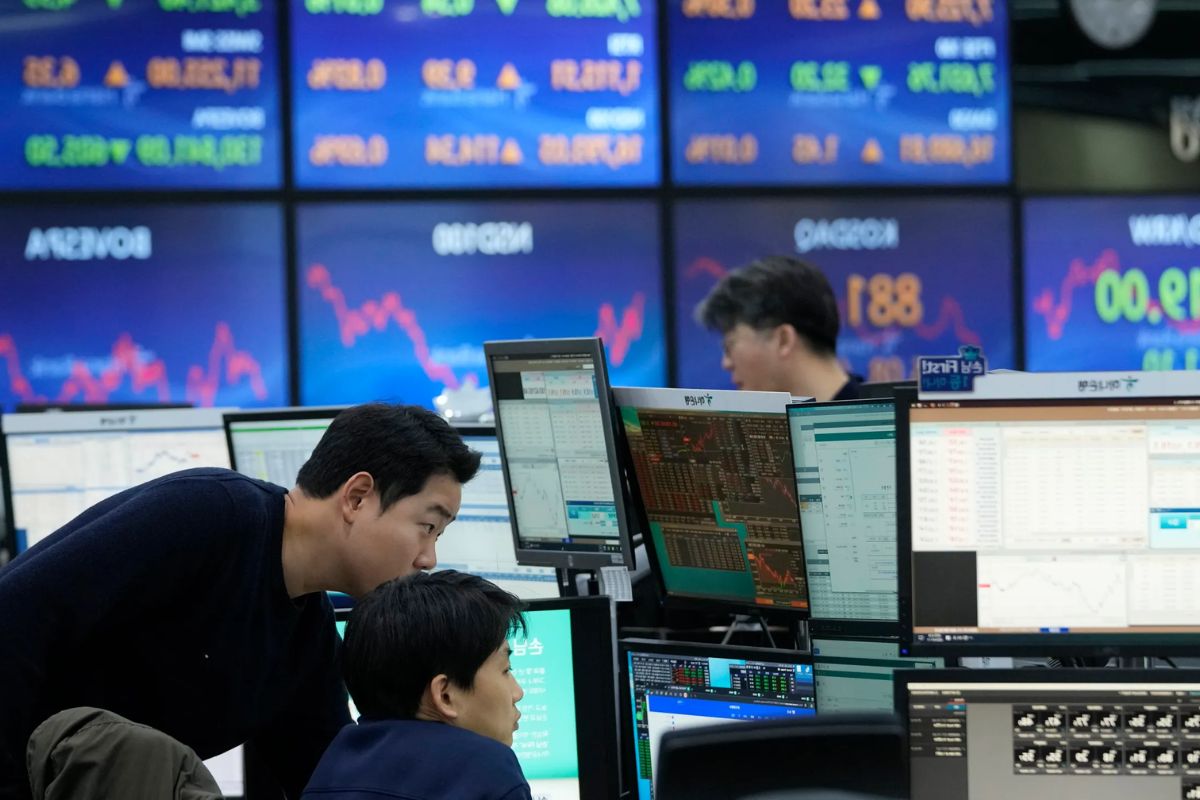Rate Cut Retreat: The recent retreat in Asian stocks, triggered by a reassessment of expectations surrounding rate cuts, has sent shockwaves through global markets.
The volatility in China’s stock market, which has been a cause for concern in recent months, has intensified as traders grapple with uncertainty. Signs of recovery in Chinese stocks had momentarily buoyed investor sentiment, but the cautious tone struck by the Federal Reserve Chairman has cast doubt on the sustainability of this rebound.
As a result, market reactions have been swift and far-reaching, with Treasury yields, the strength of the dollar, and geopolitical tensions all coming into play.
The implications of these developments are significant, leaving investors and market participants on edge as they navigate an increasingly complex and unpredictable landscape.
Key Takeaways
- Volatility in China’s stock market due to low investor sentiment and lack of policy support
- Increased purchases by state-backed investors and anticipation of policy measures to support Chinese economy indicate signs of recovery in Chinese stocks
- Federal Reserve’s decision on interest rate cuts impacting global markets and influencing investor expectations
- Federal Reserve Chairman’s cautious approach to monetary policy has significant implications for global markets and investor sentiment
China’s Stock Market Volatility
China’s stock market is currently experiencing significant volatility due to persistently low investor sentiment and a lack of policy support and broader stimulus measures. The decline in Asian shares, fueled by the robust U.S. jobs report, has further exacerbated the market’s instability. The Chinese securities regulator has pledged to prevent abnormal market fluctuations, but no specific measures have been announced, leaving analysts speculating on the need for additional steps to boost market confidence.
Also Read: Asian Stocks Surge on Optimism Over Potential Chinese Rescue Package
The persistently low investor sentiment can be attributed to several factors. Firstly, the ongoing trade tensions between China and the United States have created uncertainty and dampened investor confidence. Secondly, the lack of policy support and broader stimulus measures from the Chinese government has failed to provide a much-needed boost to the market. This lack of support has left investors feeling uncertain about the future direction of the market and hesitant to make significant investments.
In order to address this volatility and restore investor confidence, it is crucial for the Chinese government to take swift and decisive action. Implementing targeted stimulus measures, such as tax cuts or infrastructure spending, could help stimulate economic growth and bolster investor sentiment. Additionally, clear and transparent communication from the securities regulator regarding their intentions and plans to stabilize the market would go a long way in instilling confidence among investors.
Signs of Recovery in Chinese Stocks
Amidst persistently low investor sentiment and a lack of policy support, Chinese stocks have recently shown signs of recovery, particularly in the blue-chip index, after hitting a five-year low the previous week. This is an encouraging development for market participants who have been grappling with the volatility and uncertainty in the Chinese stock market.
Here are three key factors contributing to the signs of recovery:
- Increased purchases by state-backed investors: The national team, comprising state-backed investors, has stepped in to bolster the market by increasing purchases of blue-chip funds. Although their efforts have not fully countered the market slump, their presence has instilled some confidence among investors.
- Anticipation of policy measures: Market observers are eagerly awaiting the upcoming Two Sessions, where potential policy measures aimed at supporting the Chinese economy are expected to be announced. This anticipation has contributed to the recent recovery in Chinese stocks.
- Bottom-fishing opportunities: The sharp decline in Chinese stocks has created attractive buying opportunities for investors seeking to capitalize on the potential rebound. Bargain hunters are stepping in to take advantage of the low valuations, contributing to the signs of recovery.
Federal Reserve’s Impact on Global Markets
The Federal Reserve’s stance on potential interest rate cuts has become a focal point for global markets, with investors eagerly awaiting its decision in March and reassessing their expectations. The central bank’s dovish turn in December initially led to expectations of rate cuts, but recent strong economic data and resistance from central bankers have prompted a reassessment.
Current market pricing indicates a high likelihood that the Fed will maintain rates in March, impacting global financial landscapes. The robust U.S. job growth and significant wage increase in January have prompted a reevaluation of the timing for the Fed’s easing cycle. The table below summarizes the key factors influencing the Fed’s decision and their impact on global markets:
| Factors Influencing Fed’s Decision | Impact on Global Markets |
|---|---|
| Strong economic data | Increased market volatility |
| Central bankers’ resistance | Market uncertainty |
| Robust U.S. job growth | Potential for a stronger dollar |
| Significant wage increase | Potential inflationary pressures |
As global markets await the Fed’s decision in March, it is crucial for investors to closely monitor these factors and reassess their expectations accordingly.
Federal Reserve Chairman’s Cautionary Tone
After reassessing their expectations due to recent strong economic data and resistance from central bankers, investors are now focusing on Federal Reserve Chairman Jerome Powell’s cautionary tone regarding the timing of interest rate cuts.
Powell’s emphasis on prudence and the need for a delicate balance reflects a cautious approach to monetary policy. This caution is rooted in the recognition of a strong economy and the importance of building confidence in inflation trends.
Powell’s wait-and-see stance suggests that the Federal Reserve will not rush into rate cuts and will carefully evaluate the impact of economic indicators.
This cautionary tone from the Fed Chairman adds further uncertainty to the market, as investors try to gauge the path of future rate cuts. Traders will closely monitor Powell’s remarks and any shifts in the Fed’s stance, as these will have significant implications for global markets and investor sentiment.
- Powell’s cautious approach acknowledges the complexity of the economic landscape and the need for careful decision-making.
- The emphasis on building confidence in inflation trends indicates the Fed’s commitment to maintaining price stability.
- Investors will closely follow Powell’s statements and actions to gain insights into the future trajectory of interest rates.
Market Reactions: Treasury Yields, Dollar Strength, and Geopolitical Tensions
Market reactions to recent developments in Treasury yields, dollar strength, and geopolitical tensions are adding further complexity to the cautious market sentiment influenced by the Federal Reserve’s approach, strong U.S. economic indicators, and the impact of geopolitical factors on oil prices.
The increase in Treasury yields, triggered by the strong U.S. payrolls report, has led to a rise in regional bond yields, impacting countries like Australia and South Korea.
Furthermore, the U.S. dollar index has reached an eight-week peak, affecting the Japanese yen.
Geopolitical tensions in the Middle East, resulting from U.S. strikes on Iran-aligned factions, have also contributed to a rise in U.S. crude oil prices and Brent crude.
These factors are creating a challenging environment for traders as they reassess their expectations and navigate the uncertainties in the market.
Conclusion Of Rate Cut Retreat
The retreat in Asian stocks due to reassessment of rate cut expectations highlights the volatility in China’s stock market. Despite signs of recovery, global markets continue to be influenced by the Federal Reserve’s actions. The cautionary tone of the Federal Reserve Chairman further adds to the uncertainty.
This has led to reactions such as fluctuations in treasury yields, strength in the dollar, and heightened geopolitical tensions. It is evident that market dynamics are complex and sensitive to various factors.
Our Reader’s Queries
Q1 Why invest in Asian equities?
A The area boasts some of the globe’s rapidly expanding firms, providing diversification advantages as mentioned earlier. Additionally, Asian stocks frequently trade at a comparative discount compared to their Western counterparts, potentially offering more value for your investment.
Q2 Why invest in Chinese companies?
A China, hosting the world’s largest middle-class population and witnessing the growth of sophisticated domestic firms, maintains its significance as a crucial investment market. Despite the slow post-COVID-19 recovery, valuations have once again become more affordable.
Q3 Why are Chinese stocks so cheap?
A Chinese stocks reached their highest point in early 2021 but have since plummeted nearly 60%, now residing in a bear market territory, as indicated by the MSCI China Index. This downturn is attributed to a real estate debt crisis, diminishing consumer confidence, and the deceleration of China’s economy.




